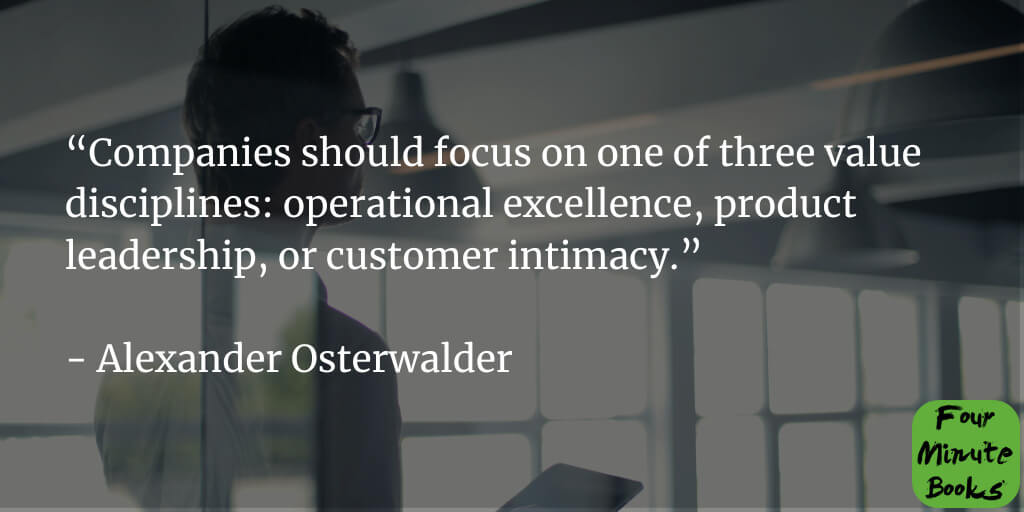1-Sentence-Summary: The Invincible Company explores the secrets of a successful company by proving how focusing on strengthening the core business values and operations while concentrating on R&D in parallel is a better strategy than just disrupting continuously and seeking new markets.
Read in: 4 minutes
Favorite quote from the author:

To survive in the market for a sustained period of time and keep the operational flow in place is one of the toughest jobs for a company. Start-ups, new technologies, political and demographic factors, and a multitude of other internal issues can bring down even the top corporations at times.
Companies often think that the solution consists in rebranding, seeking new markets, or innovation of some sort. The Invincible Company by Alexander Osterwalder proves how by focusing on the core aspects of a business and strengthening from within you can win the game.
Of course, a good dose of innovation-focused research is necessary to adapt to the changing winds. However, there’s even more to add to the list. So what should a successful company focus on? Let’s explore!
For now, here are three of my favorite lessons from this book:
- Companies that thrive need to have two core portfolios.
- Explore portfolio projects are risky but essential for future growth.
- Grow your company with the Business Model Canvas.
Running a business is nowhere near easy, but with these three strategies, it becomes manageable. Now, let’s explore every one of them!
Lesson 1: There are two core portfolios that a successful company should possess.
Essentially, a strong company must focus on a multitude of internal and external factors to build long-term success. According to the author, this can be done through two core portfolios: The “explore portfolio” and the “exploit portfolio”.
The first one focuses on innovation, research and development of new ideas, and other future benefits in relation to the level of risk. This portfolio mostly focuses on ROI (return on investment) from future projects. The exploit portfolio targets the opposite type of projects. It focuses on strengthening the core operational aspects.
The exploit portfolio targets the strengths and weaknesses of a company and tries to improve the business overall. These two portfolios are essential for any company that wishes to keep up with the consumer changes and demands, while also maintaining a strong position in the market.
Nevertheless, both projects require different teams and a skilled workforce that matches the requirements of working in innovation on one side and strengthening core operations on the other. The two teams should collaborate frequently and maintain an open communication line, yet focus on their particular tasks.
Lesson 2: The explore portfolio needs to be under continuous surveillance to generate desired returns.
Explore projects are an essential part of any future growth strategy of a company. Although they can’t provide a guaranteed value for the company they are necessary for the long-term survival of any business. Therefore, a good executive will acknowledge their nature and try to switch their focus on reducing uncertainty.
Reducing risk and increasing the acceptance rate of such projects can happen in two stages: the design loop and the testing loop. The design loop is the initial phase where team members generate ideas, design prototypes, uncover flaws in the process, and adapt as they go.
The testing phase is about experimenting with the product, producing evidence about the real-life experience of using it, and strengthening its design if needed. This phase is essential to reduce the flaws of the prototype and therefore the risk that comes with bringing it to market.
A wise executive will allocate all the necessary resources to conduct such research at any given point, and be proactive in the production of new offerings. However, it’s best to maintain a healthy dose of skepticism and minimalize errors and implied risks at all times.
Lesson 3: The Business Model Canvas can help you improve your traditional business model overall.
The Business Model Canvas is a visualization method for companies who want to improve their model, cut on costs, increase efficiency, or get a better overall view of their organization. This canvas has three main points of analysis: the front end, the back end, and the cost and revenue considerations.
The front end refers to the customer’s side of the business, the market you’re addressing, the delivery channels, and the external factors of the business: market conditions, trends, and economical conditions. The back end targets the product itself, the resources and technology used, and the stakeholders.
The last part of the canvas consists of the viability, feasibility, and cost-related part of the business. Having this structure in mind allows organizations to get a better view of their business and see what areas of improvement they can consider.
For example, a company may choose to re-revaluate their cost frame by cutting or increasing the price, the back end of the product by adding features to it, or perhaps the front end and expand into new markets.
The Invincible Company Review
The Invincible Company offers its readers an entire business course in the form of a book, due to the large variety of subjects it approaches. The author focuses on the importance of addressing all areas of a business, how to re-design an organization to keep up with the trends, how to improve a business model and many other areas of interest for any executive. Reading this book is a must if you are a decision maker in your company or own one of your own.
Who would I recommend The Invincible Company summary to?
The 36-year-old project manager who wants to learn how to set a clear direction for the new projects they took over, the 40-year-old executive who wants to scale their business while maintaining revenue security, or the 50-year-old company owner who wants to adapt to new trends but doesn’t know where to start remodeling their business.
Last Updated on October 6, 2022